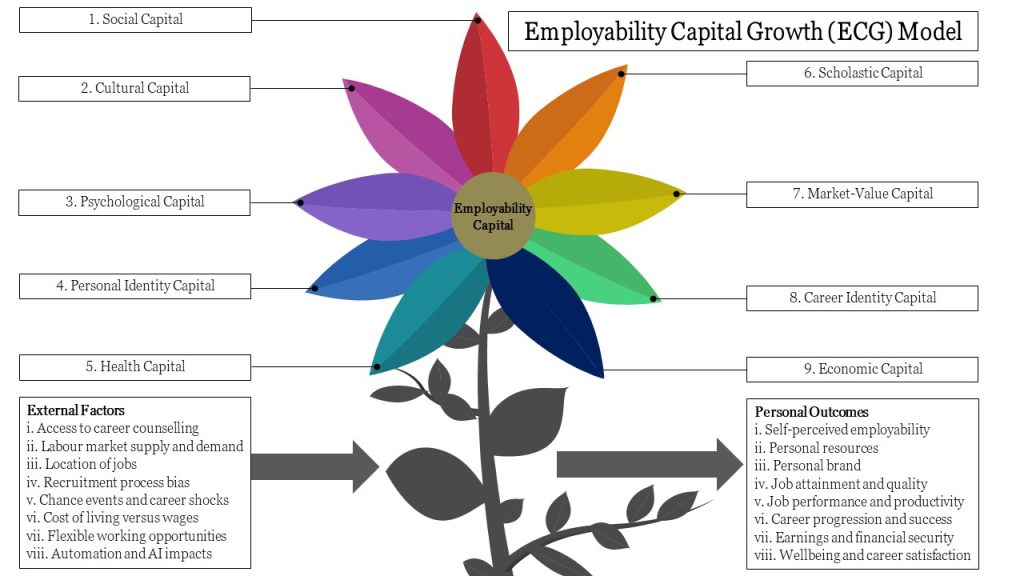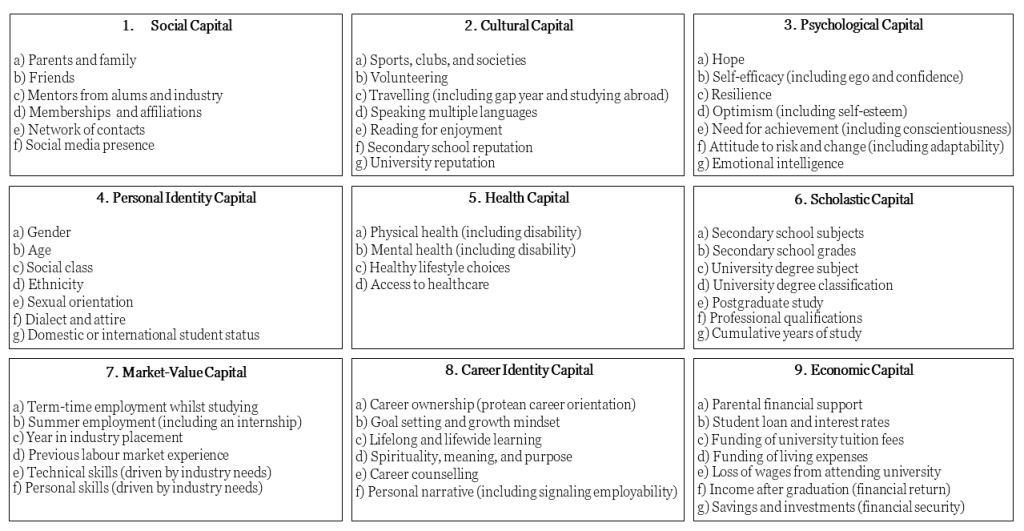|
Getting your Trinity Audio player ready...
|
Higher education institutions are tasked with producing graduates capable of offering organizations a strategic competitive advantage. Consequently, employers seek to attract, develop and retain early career talent to become the leaders of tomorrow.
The last decade has witnessed a shift by academics and career practitioners from focusing on skills-based models of graduate employability (e.g., the Understanding, Skills, Efficacy Beliefs, Metacognition (USEM) model by Yorke & Knight, 2004) for preparing students for the university-work transition, to employability capital-based models (e.g. the Self-Perceived Employability (SPE) model by Donald et al., 2019). However, various employability capital models have tended to develop interdependently, whereby researchers in different fields use similar terms to mean different things or different terms to mean the same things. Moreover, each model has strengths and weaknesses, hindering the practical value for career practitioners in university and industry settings.
To address this issue, we systematically reviewed 42,558 manuscripts published from 2016-2022, which covered graduate employability and career development fields. Focused keyword searches and manual screening subsequently left 94 relevant manuscripts for qualitative content analysis from applied psychology, business, education and management.
The analysis identified nine forms of employability capital (Figure 1) and an Employability Capital Growth (ECG) model incorporating employability capital, external factors and personal outcomes (Figure 2).
Figure 1 [© Donald, Baruch & Ashleigh, 2023]
Figure 2 [© Donald, Baruch & Ashleigh, 2023]
Application in a university setting
Within a university setting, the primary objective of deploying the ECG model is to prepare students for sustainable careers and for undertaking the university-to-work transition. Career practitioners (e.g. university career advisors, recruitment agency representatives and graduate recruiters) can follow a three-phase approach to support university students: (i) exploring the forms of capital, (ii) fostering a personalized plan, and (iii) considering external factors and personal outcomes.
Phase 1: Exploring the forms of capital
Initially, students reflect sequentially on each of the nine forms of employability capital (Figure 1) under the guidance of a career practitioner. They should also consider how the various dimensions of each form of capital can interact with each other.
Phase 2: Fostering a personalized plan
After exploring the nine forms of capital, students are prompted to assess their own strengths and areas for development. They identify which aspects of the various forms of capital they currently possess and how these can be advantageous for employers in showcasing employability during the selection process. Consequently, the student creates a personalized plan identifying the areas they need to enhance with specific and achievable goals for regular evaluation. The tailored approach ensures that each student’s needs are addressed effectively, fostering their growth and employability.
Phase 3: Considering external factors and personal outcomes
In the final phase, students need to consider the entire ECG model. When providing career guidance, there is often an excessive focus on individual control, giving students the false impression of complete power (agency) over their employment outcomes. However, students can be capable of performing a job (employable) whilst not necessarily being able to secure a job at a specific point in time (employed). By discussing external factors with students, career practitioners can help students manage their expectations and understand the role of circumstances beyond their control.
The final dimension of the ECG model focuses on personal outcomes, representing the potential benefits students can gain from proactively developing various forms of employability capital in preparation for the university-work transition. By discussing personal outcomes with students (e.g. self-perceived employability, career progression, earnings and well-being), career practitioners can motivate students to acquire various forms of capital and prepare them for the university-work transition and sustainable careers.
Application in an industry setting
Although the ECG model is primarily intended for career practitioners working with university students and graduates, many components of the nine forms of capital, external factors and personal outcomes hold value for individuals throughout their careers. In an industry setting, the focus shifts to organizational agents (e.g. human resource professionals and line managers) supporting employees to embrace lifewide learning, prepare for career transitions and navigate unforeseen circumstances for career sustainability.
For these three focus areas, we now explore how the ECG model can be combined with the GROW (Goals, Reality, Options and Will) model (Whitmore, 1992) to offer various perspectives for employees to consider during career counselling sessions.
Fostering lifewide learning
- Goal: Explore strategies for acquiring different forms of employability capital in the present or near future.
- Reality: Assess current practices and methods of acquiring employability capital.
- Options: Identify additional avenues to obtain employability capital within and outside the work environment. Determine the necessary resources you require and any support your employer could provide.
- Will: Clarify motivation to acquire various forms of employability capital at any particular moment or stage.
Preparing for career transitions
- Goal: Develop strategies to acquire different forms of employability capital for long-term career benefits.
- Reality: Evaluate upcoming career steps and identify long-term aspirations.
- Options: Determine which forms of employability capital will be most advantageous in reaching your long-term goals. Establish plans to acquire these resources.
- Will: Define motivation for your next career move and long-term vision. Examine personal outcomes of the ECG model to aid this step. Let this drive your commitment to obtaining relevant employability capital with a long-term perspective.
Navigating unforeseen circumstances
- Goal: Develop the ability to effectively navigate unexpected events and adverse career shocks that may arise during your career (e.g. being made redundant).
- Reality: Acknowledge and be prepared for the possibility of unforeseen circumstances and career shocks. Recognize the influence of external factors beyond your direct control, including those outlined in the ECG model.
- Options: Proactively identify opportunities to establish strategies and be prepared in advance. Recognize the importance of adaptability, flexibility and building a professional network as crucial aspects of employability capital and career sustainability.
- Will: Use the personal outcomes from the ECG model to act as motivation to acquire the various forms of capital proactively in preparation for navigating unforeseen events (e.g. unexpected redundancy) that may occur during one’s career.
The ECG model provides an employability capital-based model for career practitioners in university and industry settings. It highlights nine forms of employability capital, raising awareness of different employability dimensions. External factors reveal aspects beyond an individual’s direct control. Personal outcomes serve as motivation to develop employability capital. Please get in touch with Associate Professor Will Donald for more information at: w.e.donald@soton.ac.uk






